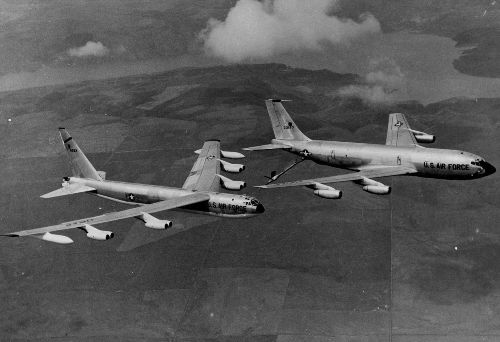
Boeing B-52 refueling (Wikipedia)
My birth family has had at least indirect involvement in these old Stratofortress planes. As a member of Air Force intelligence, my father during his career was partly responsible for the security of our S.A.C. aircraft. He wrote the U.S.A.F. manual for training young Air Force officers in the fundamentals of Air Force security and related intelligence work.
The oldest of my younger brothers was an Air Force noncommissioned officer helping monitor Russian radio exchanges in the lead-up to the 1973 Yom Kippur War and helped pass along the warning at its outset that may have resulted in our B-52s being placed on alert. For awhile he worried he might have had a hand in the beginning of World War III. Later I understand he participated in an electronic intelligence mission near Vietnam onboard a B52 that was painted black to help it avoid detection in night flying.
 Boeing B-52 refueling (Wikipedia) |
With the end of the Cold War, these old nuclear bombers had become redundant. Upgraded models of the B-52 still fly, and indeed a couple were challenging China's claim to the control of air space over disputed islands only a few weeks ago. However, the current type are not outfitted for carrying atomic or hydrogen bombs. With the 12/19 end of these old B-52 versions, the United States has fulfilled its part in a New Strategic Arms Reduction Treaty with Russia.
Nuclear deterrence seems a mixed blessing. No doubt it is effective against certain adversaries. The prospect of imminent all-out nuclear war apparently made both President Kennedy and Premier Khrushchev anxious enough to quickly end the Cuban Missile Crisis. However, "mutually assured destruction" may only be effective so long as it is never used. If our bluff is called, for instance by a rogue or terrorist nation whose leadership is unafraid to wipe out vast numbers of people in the name of ideology, religion, or patriotism, it is hard to see how anyone will be better off once such weapons are employed. Apart from the immediate horrors they would create, scientists now conclude that the multiple atomic blasts envisioned in a global thermonuclear exchange would blot out the sun's rays for an extended period, most likely doing us all in as effectively as an asteroid did to most of the dinosaurs 65 million years ago.
From a high of over 31,000 nuclear weapons, our country is now down to just about 5000, none of which are borne by manned aircraft. Though the current stockpile is quite sufficient to render our enemies' territories radioactive wastelands and initiate planet-wide nuclear winter, it is at least a much smaller hazard to humanity's continued existence than was once the case.
Primary Sources:
-Once a Mighty Bomber, a B-52 Meets Its End in the Desert. Ted Robbins on NPR - Around the Nation; December 19, 2013;
-Cold War - B-52 Stratofortress. Kennedy Hickman in About.Com - Education - Military History; last updated December 20, 2013.